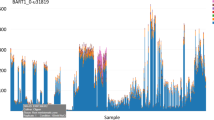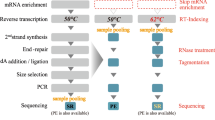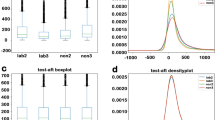Abstract
We developed a new platform for genome-wide gene expression analysis in any eukaryotic organism, which we called SuperSAGE array. The SuperSAGE array is a microarray onto which 26-bp oligonucleotides corresponding to SuperSAGE tag sequences are directly synthesized. A SuperSAGE array combines the advantages of the highly quantitative SuperSAGE expression analysis with the high-throughput microarray technology. We demonstrated highly reproducible gene expression profiling by the SuperSAGE array for 1,000 genes (tags) in rice. We also applied this technology to the detailed study of expressed genes identified by SuperSAGE in Nicotiana benthamiana, an organism for which sufficient genome sequence information is not available. We propose that the SuperSAGE array system represents a new paradigm for microarray construction, as no genomic or cDNA sequence data are required for its preparation.
This is a preview of subscription content, access via your institution
Access options
Subscribe to this journal
Receive 12 print issues and online access
$259.00 per year
only $21.58 per issue
Buy this article
- Purchase on Springer Link
- Instant access to full article PDF
Prices may be subject to local taxes which are calculated during checkout




Similar content being viewed by others
References
Schena, M., Shalon, D., Davis, R.W. & Brown, P.O. Quantitative monitoring of gene expression patterns with a complementary DNA microarray. Science 270, 467–470 (1995).
Velculescu, V.E., Zhang, L., Vogelstein, B. & Kinzler, K.W. Serial analysis of gene expression. Science 270, 484–487 (1995).
Saha, S. et al. Using the transcriptome to annotate the genome. Nat. Biotechnol. 20, 508–512 (2002).
Matsumura, H. et al. Gene expression analysis of plant host-pathogen interactions by SuperSAGE. Proc. Natl. Acad. Sci. USA 100, 15718–15723 (2003).
Matsumura, H. et al. SuperSAGE. Cell. Microbiol. 7, 11–18 (2005).
Nuwaysir, E.F. et al. Gene expression analysis using oligonucleotide arrays produced by maskless photolithography. Genome Res. 12, 1749–1755 (2002).
Bolstad, B., Irizarry, R., Astrand, M. & Speed, T. A comparison of normalization methods for high density oligonucleotide array data based on bias and variance. Bioinformatics 19, 185–193 (2003).
Nasir, K.H.B. et al. High-throughput in planta expression screening identifies a class II ethylene responsive element binding factor-like protein that regulates plant cell death and nonhost resistance. Plant J. 43, 491–505 (2005).
Aoyama, T. & Chua, N.H. A glucocorticoid-mediated transcriptional induction system in transgenic plants. Plant J. 11, 605–612 (1997).
Zeng, L.R. et al. Spotted leaf11, a negative regulator of plant cell death and defense, encodes a U-box/armadillo repeat protein endowed with E3 ubiquitin ligase activity. Plant Cell 16, 2795–2808 (2004).
Whitfield, C.W. et al. Annotated expressed sequence tags and cDNA microarrays for studies of brain and behavior in the honeybee. Genome Res. 12, 555–566 (2002).
Gracey, A.Y., Troll, J.V. & Somero, G.N. Hypoxia-induced gene expression profiling in the euryoxic fish Gillichthys mirabilis. Proc. Natl. Acad. Sci. USA 98, 1993–1998 (2001).
Argani, P. et al. Discovery of new markers of cancer through serial analysis of gene expression: prostate stem cell antigen is overexpressed in pancreatic adenocarcinoma. Cancer Res. 61, 4320–4324 (2001).
Yasui, W., Oue, N., Ito, R., Kuraoka, K. & Nakayama, H. Search for new biomarkers of gastric cancer through serial analysis of gene expression and its clinical implications. Cancer Sci. 95, 385–392 (2004).
Bryant, P.A., Venter, D., Robins-Browne, R. & Curtis, N. Chips with everything: DNA microarrays in infectious diseases. Lancet Infect. Dis. 4, 100–111 (2004).
Matsumura, H. et al. Overexpression of Bax-inhibitor suppresses the fungal elicitor-induced cell death in rice (Oryza sativa L.) cells. Plant J. 33, 425–434 (2003).
Matsumura, H. et al. SuperSAGE: A transcriptome tool for eukaryotic organisms. SAGE: Current Technologies and Applications (ed., San Ming Wang) 77–90 (Horizon Scientific Press, Norwich, U.K., 2004).
Eisen, M.B., Spellman, P.T., Brown, O.P. & Botstein, D. Cluster analysis and display of genome-wide expression patterns. Proc. Natl. Acad. Sci. USA 95, 14863–14868 (1998).
Acknowledgements
We dedicate this work to late H. Enei, the former director of Iwate Biotechnology Research Center, who strongly encouraged our study. We are grateful to Genefrontier Corp. and NimbleGen Systems Inc. for constructing and analyzing oligonucleotide arrays. This study was supported in part by a grant from the Program for Promotion of Basic Research Activities for Innovative Biosciences (Japan). Work in Berlin was supported by Deutsche Forschungsgemainshaft (KR1293/4-1).
Author information
Authors and Affiliations
Contributions
H.M. contributed to development and implementation of the core technique, K.H.B.N. contributed to NbCD1 and NbCD3 experiments, K.Y. contributed to rice experiments, A.I. contributed to NbCD1 and NbCD3 experiments, and G.K., D.H.K. and R.T. contributed to development of the core technique.
Corresponding author
Ethics declarations
Competing interests
G.K. is employed by GenXPro.
Supplementary information
Supplementary Fig. 1
Reproducibility of SuperSAGE-Array analysis in leaves and suspension-cultured cells of rice. (PDF 997 kb)
Supplementary Table 1
List of rice SuperSAGE tags spotted on the oligonucleotide array and averaged hybridization signal values in rice leaves and suspension-cultured cells. (PDF 151 kb)
Supplementary Table 2
SuperSAGE tags of genes differentially regulated by NbCD1-overexpression in N. benthamiana leaves. (PDF 94 kb)
Supplementary Table 3
SuperSAGE tags of genes differentially regulated by NbCD3-overexpression in N. benthamiana leaves. (PDF 91 kb)
Supplementary Table 4
Average of normalized hybridization signal values (Log2) of differentially expressed genes between GFP- and NbCD1-overexpressing N. benthamiana leaves. (PDF 113 kb)
Supplementary Table 5
Average of normalized hybridization signal values (Log2) of differentially expressed genes between GFP- and NbCD3-overexpressing N. benthamiana leaves. (PDF 115 kb)
Supplementary Table 6
Summary of genes isolated by RACE PCR. (PDF 47 kb)
Rights and permissions
About this article
Cite this article
Matsumura, H., Bin Nasir, K., Yoshida, K. et al. SuperSAGE array: the direct use of 26-base-pair transcript tags in oligonucleotide arrays. Nat Methods 3, 469–474 (2006). https://doi.org/10.1038/nmeth882
Received:
Accepted:
Published:
Issue Date:
DOI: https://doi.org/10.1038/nmeth882
This article is cited by
-
Age-related dysfunction of the autophago-lysosomal pathway in human endothelial cells
Pflügers Archiv - European Journal of Physiology (2019)
-
Genome sequence comparison reveals a candidate gene involved in male–hermaphrodite differentiation in papaya (Carica papaya) trees
Molecular Genetics and Genomics (2015)
-
Molecular characterization of the CRa gene conferring clubroot resistance in Brassica rapa
Plant Molecular Biology (2012)
-
Reduced representation sequencing of plant stress transcriptomes
Journal of Plant Biochemistry and Biotechnology (2012)
-
Bias correction and Bayesian analysis of aggregate counts in SAGE libraries
BMC Bioinformatics (2010)



